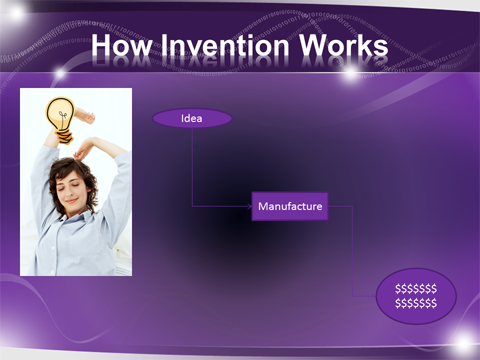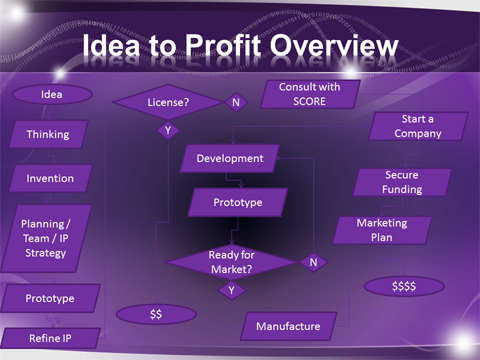.jpg)
“I Have an Idea, Now What?” – Part 1 – How Invention Works
For the last year or so I’ve given presentations at my local SCORE chapter about how to take ideas from concept to reality. It’s titled, “I Have an Idea, Now What?” It’s been very well received and I keep getting invited back so I guess they feel it’s helping people; however, for those of you who don’t know what SCORE is (in which case I hope you will look in to the organization) or don’t live in our local area where I speak, I decided to write a multi-part blog detailing the presentation. Here is my first installment.
My name is Gabriel Goldstein and I own Anidea Engineering. I started it in 2001 while I was working in conventional employment. During that, I was head hunted to work in a startup to develop some automated lighting equipment for music and entertainment venues. When that startup was written off by our financier, I took Anidea full time. Over the last 13 years, myself and my company have developed dozens of electronic and mechanical systems. Everything from little things that blink and beep to GPS golfing assistants, and cow mating detection systems.
Before all that, I attended University of Central Florida and graduated in 2000 with a BS in computer engineering. I worked as an engineer most of the time I was in school.
I come from a long line of entrepreneurs. My parents are entrepreneurs, all of my grandparents were entrepreneurs, and 2 of my 3 siblings are entrepreneurs. You can argue nature or nurture, but you can’t argue it’s not in my family.
Disclaimer
So here is where I tell you what I’m not. I’m not a lawyer or patent attorney. The content here is based on my 18+ years’ experience as an engineer and entrepreneur, your mileage may vary. Everyone’s situation is different and needs specific evaluation.
How Invention Works
 So most people think this is the way invention works. You wake up one day with this idea and get all excited. You do some Google searching (maybe), find a manufacturer, then you sit back and wait for the money to roll in. Keep an eye on the dollar signs in the presentation, they are proportional.
So most people think this is the way invention works. You wake up one day with this idea and get all excited. You do some Google searching (maybe), find a manufacturer, then you sit back and wait for the money to roll in. Keep an eye on the dollar signs in the presentation, they are proportional.
How Invention Really Works
 So this slide is still overly simplified. There are many, many ways to get your idea to a profitable state. The key decision is whether you want to start and run a company or license. Sure there are lots of people who will offer free or cheap help, but you usually get what you pay for. In this world, the more you put into something the more you get out; the higher the risk, the higher the reward. There are exceptions (they are called luck), but you should be familiar with these life concepts by now. There will be more on this later. The key thing to understand here is that it’s a lot of work and it’s quite complex.
So this slide is still overly simplified. There are many, many ways to get your idea to a profitable state. The key decision is whether you want to start and run a company or license. Sure there are lots of people who will offer free or cheap help, but you usually get what you pay for. In this world, the more you put into something the more you get out; the higher the risk, the higher the reward. There are exceptions (they are called luck), but you should be familiar with these life concepts by now. There will be more on this later. The key thing to understand here is that it’s a lot of work and it’s quite complex.
Why Am I not Rich Yet?
So you have this idea, you’ve toyed around a bit with it, and you have expectations that it is really a good idea. So you may be wondering why the world isn’t blazing a path to your door. Thomas Edison said “Genius is 1% inspiration, and 99% perspiration”. Another famous person, Ashton Kutcher stood up at the Teen Choice Awards in 2013 and stated, “I believe that opportunity looks a lot like hard work.” He didn’t discover this thought. Credit goes back to the 1900s or so. You have not yet begun to perspire. So yeah, I get that quoting Kutcher may sound strange. For those of you reading this, people used to tell me I looked like him a lot when I was younger and he was more famous. I’m also just trying to be relevant to the ‘kids’ out there. J
Idea
Time for some definitions. So an idea is just the most basic starting point. It has little intrinsic value. People have lots of ideas, some are good; most are bad. Don’t get too caught up on any one idea. Ideas need to be nurtured and researched. Linus Pauling said, “The best way to have a good idea is to have lots of ideas”.
Things to consider:
Do You Have an Invention?
So how do you know if your idea is an invention or not. A time ago, this would have been a relatively difficult task. Nowadays, one word, “Google”. Google it, Google it again. Use alternate search phrases. Ask close friends how they might describe it, then Google that. I can’t stress this enough. Many times I’ve been sitting in new client interviews and as they start describing their product, I find it on Google, Ebay, or USPTO (United States Patent & Trademark Office) in 5 minutes. After you’ve exhausted Google, move to the USPTO.gov site and search there for a while, then pay for a professional patent search.
Is Your Baby Ugly?
This is a tough one. Not all your ideas are good ones. Some are ahead of their time or just don’t have the marketability to sustain a profitable product development cycle. Talk to trusted associates. Get honest feedback on your idea. Validation is key. Investors always want an idea to be proved out to some point. You are your own investor. Validate your idea before sinking too much time and effort into your idea. You will need to strike a balance between keeping your idea confidential and talking to enough people and assessing the marketability of your idea. Remember, you need to think about this like you are starting a business. If you are not out to make money and run this like a business, it’s a hobby. There is nothing wrong with hobbies, just keep that in mind as you make what are really business decisions.
Risk Assessment
One should consider what they are willing to put on the line to achieve their dreams. Not all ideas should be a bet-the-farm, let it all hang out, all-in venture. Most should not for that matter. However, this is what sets apart the men from the boys. All businesses and ideas take risk. You have to. Few things in life are guaranteed, just death and taxes. Do you have a lot of ideas to build a company around? Are you prepared to quit your day job? What will be sacrificed for you putting in another 30 hours a week in at night while you do the leg work to build your new business (something will, no exceptions).
My point here is that you need to take smart, calculated risks. Don’t dump your life savings into an idea before you know you have a market. Do spend some seed money for a proof of concept for some market research to prove your direction is solid. Do get enough validation, convince others, and get help.
This is entrepreneurship. Believing in something before anyone else believes in it. If you are going go down this path, you have to be prepared for a rough road. You get out what you put into it. At this point you are likely to have more time than money.
Have a comment?
Make it public on social media using the links to the left. You can also send a private comment to us below.
